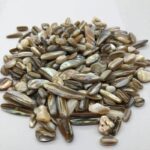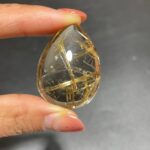Introduction: A Journey into the Heart of Serpentine
Delve into the captivating world of serpentine stone, a mineral shrouded in myths and legends. Its name echoes the serpentine’s graceful movements, reflecting the stone’s serpentine structure. This extraordinary mineral possesses a remarkable ability to transform, resembling the ever-changing nature of the serpent.

Unveiling the Properties of Serpentine
Exploring the physical and chemical attributes of serpentine reveals its unique composition.
-
Chemical Composition: Serpentine belongs to the silicate mineral group, primarily composed of magnesium, silicon, and oxygen. Its formula is Mg3Si2O5(OH)4.
-
Mohs Hardness: Measuring a Mohs hardness of 3.5 to 4, serpentine ranks between calcite and fluorite on the scale. Despite its relatively low hardness, it exhibits notable durability.
-
Structure: Serpentine’s telltale serpentine structure arises from its interlocking platy crystals. This serpentine-like texture sets it apart from other minerals.
Exploring the Varieties of Serpentine
The versatile nature of serpentine encompasses a spectrum of variations, each with its distinct characteristics.
-
Antigorite: Predominantly green, antigorite comprises fibrous crystals that impart a silky luster.
-
Chrysotile: Characterized by its white to yellow-green color, chrysotile is a fibrous variety that exhibits a silky sheen.
-
Lizardite: Displaying a range of colors from light green to dark green, lizardite possesses a greasy or waxy luster.
Uncovering the Healing Properties of Serpentine
Serpentine has been treasured for centuries for its purported healing properties, believed to enhance physical, emotional, and spiritual well-being.
-
Physical Healing: Proponents claim that serpentine can alleviate muscular tension, reduce inflammation, and promote tissue regeneration.
-
Emotional Healing: Practitioners believe that serpentine fosters emotional stability, soothes anxiety, and promotes self-acceptance.
-
Spiritual Healing: Serpentine is said to facilitate spiritual growth, enhance intuition, and connect individuals to the Earth’s energy.
Harnessing Serpentine’s Energy: A Practical Guide
Incorporating serpentine into daily life offers numerous opportunities to tap into its transformative energy.
-
Jewelry: Wearing serpentine jewelry, such as necklaces, bracelets, or earrings, allows for constant contact with the stone’s vibrations.
-
Meditative Practices: Holding serpentine during meditation can amplify the stone’s calming and centering effects.
-
Home Décor: Placing serpentine crystals in living spaces promotes a sense of tranquility and grounding.
Applications of Serpentine: Embracing Versatility
Beyond its metaphysical properties, serpentine finds diverse applications in various industries.
-
Construction: Serpentine is commonly used as a dimension stone for countertops, flooring, and decorative elements.
-
Fire Resistance: Some varieties of serpentine possess excellent fire-resistant properties, making them ideal for fireproofing applications.
-
Abrasives: Chrysotile, a type of serpentine, is utilized as an abrasive in the production of sandpaper and other polishing materials.
Serpentine’s Resilience: A Model for Human Transformation
Reflecting on serpentine’s physical and energetic properties unveils a profound lesson in resilience. Just as the serpent shed its skin to adapt and thrive, serpentine embodies the power of transformation. This constant metamorphosis reminds us that we, too, possess the resilience to overcome challenges and emerge stronger.
Tables on Serpentine
Table 1: Physical Properties of Serpentine
| Property | Value |
|---|---|
| Mohs Hardness | 3.5-4 |
| Cleavage | Poor |
| Fracture | Uneven |
| Specific Gravity | 2.5-2.7 |
| Color | Green, yellow-green, dark green |
Table 2: Types of Serpentine
| Variety | Color | Luster |
|---|---|---|
| Antigorite | Green | Silky |
| Chrysotile | White to yellow-green | Silky |
| Lizardite | Light green to dark green | Greasy or waxy |
Table 3: Healing Properties of Serpentine
| Physical | Emotional | Spiritual |
|---|---|---|
| Relieves muscular tension | Soothes anxiety | Facilitates spiritual growth |
| Reduces inflammation | Promotes self-acceptance | Enhances intuition |
| Promotes tissue regeneration | Connects to the Earth’s energy |
Table 4: Applications of Serpentine
| Industry | Application | Example |
|---|---|---|
| Construction | Dimension stone | Countertops, flooring, decorative elements |
| Fire Resistance | Fireproofing | Fire-resistant coatings, fire-resistant insulation |
| Abrasives | Sandpaper, polishing materials | Chrysotile, a type of serpentine |
FAQs on Serpentine
-
Is serpentine a safe mineral? Yes, serpentine is generally considered a safe mineral, although certain varieties may contain asbestos. It is recommended to purchase serpentine from reputable sources to ensure its safety.
-
How do I identify serpentine? Serpentine can be identified by its serpentine structure, green or yellow-green color, and low hardness.
-
What does serpentine symbolize? Serpentine is often associated with transformation, healing, and resilience. It is said to promote physical, emotional, and spiritual well-being.
-
Can serpentine be used in jewelry? Yes, serpentine is frequently used in jewelry making, creating beautiful and meaningful pieces.
-
How can I incorporate serpentine into my home? Serpentine crystals can be placed in living spaces, such as bedrooms or meditation rooms, to promote tranquility and grounding.
-
What are the benefits of using serpentine in construction? Serpentine is a durable material with fire-resistant properties, making it suitable for countertops, flooring, and other construction applications.
-
Can serpentine be used for abrasives? Chrysotile, a type of serpentine, is commonly utilized as an abrasive in the production of sandpaper and other polishing materials.
-
What is the origin of serpentine? Serpentine is commonly found in metamorphic rocks, formed through the alteration of other minerals, such as olivine or pyroxene.




























